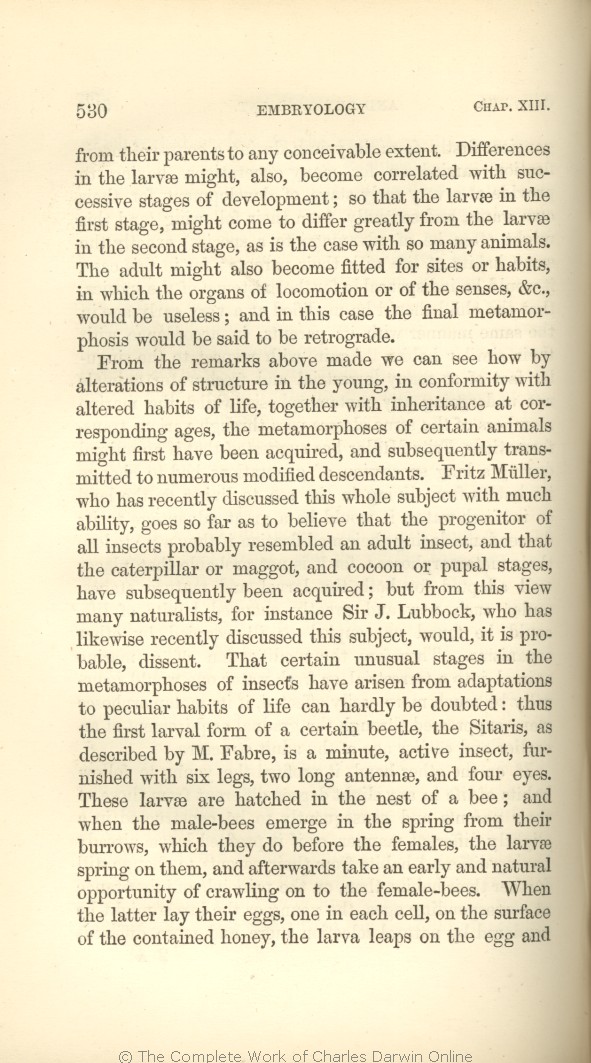|
from their parents to any conceivable extent. Differences in the larvæ might, also, become correlated with successive stages of development; so that the larvæ in the first stage, might come to differ greatly from the larvæ in the second stage, as is the case with so many animals. The adult might also become fitted for sites or habits, in which the organs of locomotion or of the senses, &c., would be useless; and in this case the final metamorphosis would be said to be retrograde. |
From the remarks
above
made we can see how by
alterations | alterations 1866 | | changes 1869 1872 |
| altered 1866 | | changed 1869 1872 |
| the metamorphoses of certain animals might first have been acquired, and subsequently transmitted to numerous modified descendants. 1866 |
| animals in certain cases might come to pass through stages of development, perfectly distinct from their primordial, adult condition. 1869 |
| animals might come to pass through stages of development, perfectly distinct from the primordial condition of their adult progenitors. 1872 |
| 6 blocks not present in 1859 1860 1861 1866 1869; present in 1872 | | Most of our best authorities are now convinced that the various larval and pupal stages of insects have thus been acquired through adaptation, and not through inheritance from some ancient form.
The curious case of Sitaris— a beetle which passes through certain unusual stages of development— will illustrate how this might occur.
The first larval form is described by M. Fabre, as an active, minute insect, furnished with six legs, two long antennæ, and four eyes.
These larvæ are hatched in the nests of bees; and when the male-bees emerge from their burrows, in the spring, which they do before the females, the larvæ spring on them, and afterwards crawl on to the females whilst paired with the males.
As soon as the female bee deposits her eggs on the surface of the honey stored in the cells, the larvæ of the Sitaris leap on the eggs and devour them.
Afterwards they undergo a complete change; their eyes disappear; their legs and antennæ become rudimentary, and they feed on honey; so that they now more closely resemble the ordinary larvæ of insects; ultimately they undergo a further transformation, and finally emerge as the perfect beetle.
|
| goes so far as to 1866 |
| OMIT 1869 |
| believe 1866 | | believes 1869 |
| probably 1866 | probably 1869 |
| and 1866 |
| stages, as well as the 1869 |
| arisen from 1866 |
| been acquired through 1869 |
| adaptations 1866 | | adaptation 1869 |
| doubted: 1866 | | a doubt: 1869 |
| a minute, active 1866 |
| an active, minute 1869 |
| in the spring 1866 |
| OMIT 1869 |
| burrows, 1866 | | burrows 1869 |
| do 1866 |
| spring, which they do 1869 |
| take an early and natural opportunity of crawling on to the female-bees. 1866 |
| crawl on the females whilst paired with the males. 1869 |
| When the latter 1866 |
| As soon as the females 1869 |
| one in each cell, 1866 |
| OMIT 1869 |
| contained 1866 | contained 1869 |
| the larva 1866 |
| stored in their cells, the larvæ of the Sitaris 1869 |
|









